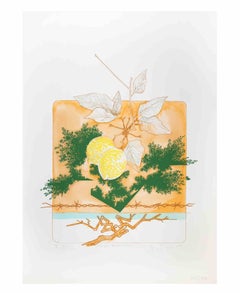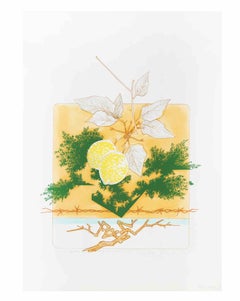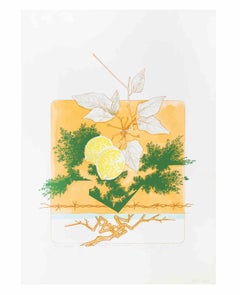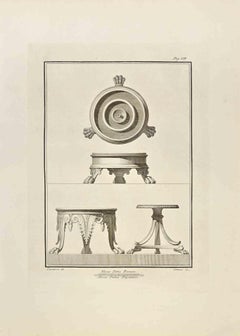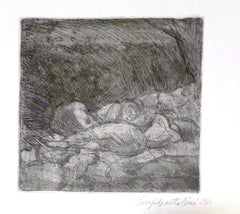Drawing Still-life Prints
to
74
212
78
69
11
14
Overall Width
to
Overall Height
to
101
91
68
14
8
8
6
3
3
3
2
1
28
12
8
7
7
12
15
289
68
1
3
3
23
26
54
82
48
10
5
268
101
14
864
781
705
498
429
384
273
272
239
195
192
186
157
155
139
136
132
131
113
107
136
128
54
40
27
24
119
211
151
Art Subject: Drawing
Still life - Screen Print by Leo Guida - 1976
By Leo Guida
Located in Roma, IT
Still Life is an artwork realized in 1976 by the Italian Contemporary artist Leo Guida (1992 - 2017).
Screen print on cardboard
Hand-signed on the lower right in pencil and dated...
Category
1970s Contemporary Still-life Prints
Materials
Screen
Still Life - Screen Print by Leo Guida - 1976
By Leo Guida
Located in Roma, IT
Still Life is an artwork realized in 1976 by the Italian Contemporary artist Leo Guida (1992 - 2017).
Screen print on cardboard
Hand-signed on the lower right in pencil and dated...
Category
1970s Contemporary Still-life Prints
Materials
Screen
Still Life - Screen Print by Leo Guida - 1976
By Leo Guida
Located in Roma, IT
Still Life is an artwork realized in 1976 by the Italian Contemporary artist Leo Guida (1992 - 2017).
Original screen print on cardboard
Hand-signed on the lower right in pencil ...
Category
1970s Contemporary Still-life Prints
Materials
Screen
Still Life - Etching by Carlo Cataneo - 18th Century
Located in Roma, IT
Still Life from "Antiquities of Herculaneum" is an etching on paper realized by Carlo Cataneo in the 18th Century.
Signed on the plate.
Good conditions with folding, due to the tim...
Category
18th Century Old Masters Still-life Prints
Materials
Etching
Homage to Jean Cocteau - Lithograph by Giancarlo Limoni - 1987
Located in Roma, IT
Homage to Jean Cocteau is a beautiful brown-ink lithograph on paper, realized in 1987 by the Italian artist Giancarlo Limoni .
Hand-signed , dated, and titled "Omaggio a Cocteau/Limoni 87 " with a brown pencil on the lower margin. Edition 138 of 150 prints.
This contemporary artwork representing an abstract composition is in excellent conditions.
Giancarlo Limoni was born in Rome in 1947, where he lives and works. In 1975, he opened his first personal exhibition at the "Galleria della Trinità" in Rome. In 1983-84, he briefly studied at the Pastificio Cerere, where Fabio Sargentini...
Category
1980s Contemporary Figurative Prints
Materials
Lithograph
Women Sleeping - Original Etching by Luigi Bartolini - 1940
Located in Roma, IT
Signed and dated by the Artist with pencil at lower left. Very good conditions. Luigi Bartolini (1892 – 1963) was an Italian painter, writer, and poet.
Image dimensions: 16.6 x 17.5...
Category
1940s Figurative Prints
Materials
Etching
Salvador Dali - The Tournament of Galore - Original Handsigned Etching
Located in Collonge Bellerive, Geneve, CH
Salvador Dali - Original Handsigned Etching
From La Quête du Graal
Dimensions: 45 x 33 cm
Handsigned
Edition: 38/100
From the rare additional suite of 100 aside from the edition of ...
Category
1970s Surrealist Figurative Prints
Materials
Etching
Wild Flowers VIII, Modern Etching by Aubrey Schwartz
Located in Long Island City, NY
Aubrey Schwartz, American (1928 - 2019) - Wild Flowers VIII, Year: 1966, Medium: Etching, signed and numbered in pencil, Edition: 28/100, Image Size: 4.75 x 3.75 inches, Size: 14 x...
Category
1960s Modern Still-life Prints
Materials
Etching
SURVIVOR TREE Signed Lithograph, Surreal Drawing, Fantasy Tree Portrait, Roots
By Hanna Kay
Located in Union City, NJ
SURVIVOR TREE is an original, hand drawn limited edition lithograph(not a photo reproduction or digital print) printed in khaki grey ink using traditional hand lithography techniques on white archival printmaking paper 100% acid free. SURVIVOR TREE is a highly detailed fantasy tree portrait, meticulously drawn with its roots clinging to a circular platform suspended in the air. SURVIVOR TREE is masterfully expressed with fine pencil markings that create the intricate foliage crown, massive trunk, and multi-fingered roots. SURVIVOR TREE is truly an imaginative, surreal tree portrait presenting a mysterious lone tree surviving in time and space .
Superb quality, hand crafted original lithograph, very fine impression.
Print size - 23 x 28.5 inches, unframed, excellent condition, pencil signed by Hanna Kay...
Category
1970s Surrealist Still-life Prints
Materials
Lithograph
Still Life With Bottles - Etching by André Dunoyer de Segonzac- 1950s
Located in Roma, IT
Still Life With Bottles is an etching and drypoint realized by André Dunoyer de Segonzac (1884-1974) in the mid-20th Century.
Good condition on a yellowed paper.
Hand-signed by the artist on the plate.
Limited edition of 60 copies numbered and signed.
André Dunoyer de Segonzac (7 July 1884 – 17 September 1974) was a French painter and graphic artist.In 1947, he published his suite of etchings illustrating the Georgics of Virgil. In the judgement of Anne Distel, chief curator of the Musée d'Orsay, "The technical perfection and the nobility of the tone, which carried the cachet of the original, but was imbued throughout with an unfailing lyricism, make this work Segonzac's masterpiece. It must be included in a list of the most beautifully illustrated books of [the 20th] century."The gossamer quality of his etchings stood in contrast to the thickly painted surfaces and generally somber color of his oil paintings, which reflected his admiration for Courbet and Cézanne. His subjects include landscapes, still lifes, and nudes. He influenced other artists like Samuel Peploe...
Category
1950s Modern Figurative Prints
Materials
Etching
Blue Rose - Etching by Giacomo Porzano - 1970s
Located in Roma, IT
Blue Rose is a contemporary artwork realized by Giacomo Porzano in 1970s.
Colored etching
Hand-signed on the lower right.
Numbered on the lower left.
Edition V/X
Giacomo Porzano...
Category
1970s Contemporary Figurative Prints
Materials
Etching
Arbre sans titre, by Francois Houtin
Located in Palm Springs, CA
Signed, titled and numbered in pencil, 3/50. Imaginary topiary and garden scene, with incredibly fine line work in the etching.
François Houtin was born in Craon en Mayenne, France...
Category
1970s Contemporary Landscape Prints
Materials
Etching
Homage to Jean Cocteau - Original Lithograph by Giancarlo Limoni - 1987
Located in Roma, IT
Homage to Jean Cocteau is a beautiful brown-ink lithograph on paper, realized in 1987 by the Italian artist Giancarlo Limoni.
Hand-signed, dated, and titled "Omaggio a Cocteau/Limon...
Category
1980s Figurative Prints
Materials
Lithograph
To Parents One Had to Hurt from the Rilke Portfolio, lithograph by Ben Shahn
By Ben Shahn
Located in Long Island City, NY
Artist: Ben Shahn, American (1898 - 1969)
Title: To Parents One Had to Hurt from the Rilke Portfolio
Year: 1968
Medium: Lithograph on Arches, signed in the plate
Edition: 750
Size: 2...
Category
1960s Modern Figurative Prints
Materials
Lithograph
Garden - Original Drawing by Gustave Pierre - Early 20th Century
Located in Roma, IT
Garden is an Original Pencil Drawing realized by Gustave Pierre.
No signature, but Stamp signed on the back.
Good condition included a white cardboard passpartout (37x55 cm).
Gustave René Pierre...
Category
Early 20th Century Modern Figurative Prints
Materials
Pencil
Blue Pavilion
By Jean Bardon
Located in Palm Springs, CA
The formality, ornamental qualities and boldness of botanical art strongly influence Bardon's art. It is easy to see her inspiration in the patterns, line and simplicity of form foun...
Category
21st Century and Contemporary Contemporary Still-life Prints
Materials
Etching, Aquatint
BRUSSEL-SMITH SELF PORTRAIT Hand Drawn Stone Lithograph, Bearded Man w Pipe
Located in Union City, NJ
BRUSSEL-SMITH SELF PORTRAIT is an original hand drawn stone lithograph by the American artist Bernard Brussel-Smith, hand printed by Master printer Joseph Kleineman, JK Fine Art Edit...
Category
1970s Realist Portrait Prints
Materials
Lithograph
YELLOW CALLA LILLIES
By Jim Dine
Located in Portland, ME
Dine, Jim (American, born 1935). YELLOW CALLA LILLIES. D'Oench and Feinberg 19. Etching, soft-ground, drypoint, photogravure and electric tools, with hand-...
Category
1970s Still-life Prints
Materials
Drypoint, Etching
Chevaliers - Original Screen Print by Rosario Mazzella - 1970s
Located in Roma, IT
Image dimensions: 56 x 35.8 cm.
Chevaliers is an original colored serigraph on Fabriano on watermarked paper realized by the Italian artist Rosario Mazzella (1932).
A colorful orig...
Category
1970s Contemporary Still-life Prints
Materials
Screen
Shepard Fairey Stencil Letterpress Rose Shackle Screenprint Contemporary Street
Located in Draper, UT
Manufacturer:
Obey Giant
Edition Details:
Year: 2019
Class: Fine Art Print
Status: Official
Released: 01/08/19
Run: 417/450
Technique: Letterpress
Paper: Cream Cotton
Size: 10 X 13
M...
Category
2010s Pop Art Still-life Prints
Materials
Screen
Minima Michaella matryoshka
Located in Palm Springs, CA
Signed and numbered from the edition of 15. Russian toys and ceramic fold art on a table. Predominantly red, yellow and blue.
Yuji Hiratsuka was born 1954 in Osaka, Japan. In 1985 h...
Category
2010s Contemporary Portrait Prints
Materials
Intaglio
Salvador Dali - The Lane of the Birches - Original Stamp-Signed Etching
Located in Collonge Bellerive, Geneve, CH
Salvador Dali - The Lane of the Birches - Original Stamp-Signed Etching
Stamp signed by Dali
Edition of 294 copies.
Paper : Arches vellum.
Dimensions : 16x12".
Catalogue Raisonné ...
Category
1960s Surrealist Figurative Prints
Materials
Etching
Dry Flowers in the Landscape - Original Etching by Marco Bellagamba - 1968
Located in Roma, IT
Dry Flowers in the Landscape is a beautiful etching, realized by the Italian artist, Mario Bellagamba, in 1968s.
Hand-signed and dated in pencil on lower-right. Notes, on the botto...
Category
1960s Figurative Prints
Materials
Etching
Still Life 1965 - Original Screen Print by Leo Guida - 1965
By Leo Guida
Located in Roma, IT
Still Life 1965 is an original black serigraph realized by Leo Giuda.
Hand-signed on the lower left corner and in very good condition.
Leo Guida artist sensitive to current issues,...
Category
1960s Abstract Figurative Prints
Materials
Paper, Screen
Fishbone - Etching by Massimo Baistrocchi - 20th Century
Located in Roma, IT
"Fishbone" is a beautiful print in etching technique, realized by Massimo Baistrocchi.
Numbered 19/50. Illegible Hand signed, on the lower right.
Image Dimensions: 9.8 x 11.5 cm
T...
Category
20th Century Modern Figurative Prints
Materials
Etching
Vase of Flowers - Etching on Cardboard by Danilo Bergamo - 1980s
Located in Roma, IT
Vase of Flowers is an original etching on cardboard realized by Danilo Bergamo in 1980s.
Hand-signed on the lower right margin on slab.
Good conditions.
Danilo Bergamo (1938) aft...
Category
1980s Modern Figurative Prints
Materials
Etching
Still Life - Original Lithograph by Jacques Lestrille - 20th Century
Located in Roma, IT
Still Life is an original lithograph on paper realized by Jacques Lestrille (1904-?)
Hand-signed on the lower right in pencil, numbered on the lower left, edition 7/14 prints.
The ...
Category
20th Century Figurative Prints
Materials
Lithograph
Wild Flowers II, Modern Etching by Aubrey Schwartz
Located in Long Island City, NY
Aubrey Schwartz, American (1928 - 2019) - Wild Flowers II, Year: 1966, Medium: Etching, signed and numbered in pencil, Edition: 28/100, Image Size: 4.75 x 3.75 inches, Size: 14 x 1...
Category
1960s Modern Still-life Prints
Materials
Etching
White Fish from Nantucket Series, Minimalist Screenprint by Bob Cato
Located in Long Island City, NY
Bob Cato, American (1923 - 1999) - White Fish from Nantucket Series, Year: circa 1970, Medium: Screenprint on Somerset, signed, titled and numbered in penci...
Category
1970s Minimalist Still-life Prints
Materials
Screen
Marsh Land from Nantucket Series, Minimalist Screenprint by Bob Cato
Located in Long Island City, NY
Bob Cato, American (1923 - 1999) - Marsh Land from Nantucket Series, Year: circa 1970, Medium: Screenprint on Somerset, signed, titled and numbered in penci...
Category
1970s Minimalist Still-life Prints
Materials
Screen
Still Life with Rabbit - Original Etching by J.-M. Estébe - Second Half of 1900
Located in Roma, IT
Still LIfe with Rabbit is an original artwork realized by Jean-Marie Estébe in the first half pf the XX Century. Etching on paper.
Hand-signed ...
Category
Late 20th Century Still-life Prints
Materials
Etching
Swallowtail Butterfly, Guy Allen, Limited Edition Print, Affordable Animal Art
By Guy Allen
Located in Deddington, GB
Please note the price is for the unframed original etching .
Swallowtail Butterfly is an original etching, engraved onto a copper plate, from wh...
Category
21st Century and Contemporary Minimalist Still-life Prints
Materials
Gold Leaf
Muskrat Traps-Poster. Copyright Aaron Ashley, Inc.
By (after) Andrew Wyeth
Located in Chesterfield, MI
Poster. Measures 19.5 x 27.75 inches and is Unframed. Good/Fair Condition-signs of wear consistent with age and handling.
Category
Late 20th Century Still-life Prints
Materials
Color
$160 Sale Price
20% Off
Electric Tulip (Black and White), Photorealist Floral Etching by Lowell Nesbitt
Located in Long Island City, NY
Photorealist flower screenprint by American artist Lowell Blair Nesbitt, signed and numbered in pencil.
Electric Tulip (Black and White)
Lowell Blair N...
Category
1970s Photorealist Still-life Prints
Materials
Etching
"4 (Recalculate Your Balance)", silkscreen print, double-sided, cotton rag paper
Located in Toronto, Ontario
"4 (Recalculate Your Bank Balance)", 2018, is a limited-edition silkscreen print, double-sided by Andrew Cornell Robinson. This print is an edi...
Category
21st Century and Contemporary Contemporary Figurative Prints
Materials
Paper, Archival Paper, Color, Screen
New York, Cityscape Art, New York Prints, Classic Art, Monochrome Cityscape Art
By John Duffin
Located in Deddington, GB
Manhattan Island looking out to the Statue of Liberty and Brooklyn as viewed from Rockefeller Centre. One of the greatest views in the world, I will always love you New York...
John ...
Category
21st Century and Contemporary Minimalist Landscape Prints
Materials
Paper, Etching
Mikelis day. 1984. Paper, linocut, 25x34 cm
Located in Riga, LV
Mikelis day. 1984. Paper, linocut, 25x34 cm
imprint size 13x26 cm total page size 25x34cm
Dainis Rozkalns (1928 - 2018)
Artist, graphic artist, illustrator of folklore and fiction ...
Category
1980s Folk Art Still-life Prints
Materials
Paper, Linocut
$187 Sale Price
20% Off
Of Light, White Sleeping Women from the Rilke Portfolio, lithograph by Ben Shahn
By Ben Shahn
Located in Long Island City, NY
Artist: Ben Shahn, American (1898 - 1969)
Title: Of Light, White Sleeping Women in Childbed from the Rilke Portfolio
Year: 1968
Medium: Lithograph on Arches, signed in the plate
Edit...
Category
1960s Modern Figurative Prints
Materials
Lithograph
(Title Unknown)-Botanical Print. Printed in Italy
Located in Chesterfield, MI
Botanical print. Plate-signed. Measures 22.25 x 16.375 in. Unframed. Printed in Italy. Good Condition.
Category
Late 20th Century Still-life Prints
Materials
Lithograph
$120 Sale Price
20% Off
Set of Two Hand-Colored Lithographs from Roscoe's "Monandrian Plants" /// Botany
Located in Saint Augustine, FL
Artist: William Roscoe (English, 1753-1831)
Title: "Maranta Arundinacea (Arrowroot)" and "Phrynium Grandiflorum"
Portfolio: Monandrian Plants of the order Scitamineae, Chiefly Drawn ...
Category
1820s Victorian Still-life Prints
Materials
Watercolor, Lithograph
Elizabeth Quandt 'Aries III' Limited Edition, Signed Etching of Ram's Head
Located in San Rafael, CA
Elizabeth Quandt (1922 - 1994)
Aries III, 1978
Etching on Arches paper
Singed and dated in pencil, lower right
Edition IX/L (9/50)
With artist's embossed stamp to lower center
Image 11 1/2in H x 6 1/2in Lin x 11in: Sheet 22 1/4in H x 18in L. Unframed.
The ram's skull pictured was found entwined in a stand of trees in Mendocino by the artist's grandchild, Timothy Brien Mailliard.
The first 25 prints in this edition of 50 are identified by Roman numerals and comprise the portfolio suite...
Category
Late 20th Century Contemporary Still-life Prints
Materials
Etching
Dedication to Valmiera city. 1982, linocut, print size 60x42 cm; total 70x55 cm
Located in Riga, LV
Dedication to Valmiera city. 1982, linocut, print size 60x42 cm; total 70x55 cm
Dainis Rozkalns (1928 - 2018)
Artist, graphic artist, illustrator of folklore and fiction publicatio...
Category
1980s Abstract Geometric Landscape Prints
Materials
Paper, Linocut
John Duffin, Thames Bridge - Looking West, London Art, Cityscape Art, River Art
By John Duffin
Located in Deddington, GB
Thames Bridges – Looking West
John Duffin
Limited Edition Etching Printed on White 300g Somerset Paper
Edition of 150
Signed – John Duffin
Image Size: H 38cm x W 25cm
Sheet Size: H 56cm x W 38cm x D 0.1cm
This work is sold unframed
Free Shipping
Please Note that in situ images are purely an indication of how a piece may look
Thames Bridge – Looking West is a limited edition cityscape print on London by artist, John Duffin. Duffin’s acute attention to detail gives the work a bold aesthetic.
John Duffin is a painter and printmaker whose work is based on the modern environments of cities and towns, creating dynamic, cinematic images of contemporary urban life. His unique images of architecture, lighting and figures have been greatly praised and awarded, recently receiving The Most Outstanding Print Award from Sir peter Blake, he has a distinctive artistic voice and has much to say in his work about contemporary life in all of it’s manifestations. His work is in the tradition of LS Lowry...
Category
21st Century and Contemporary Baroque Landscape Prints
Materials
Paper, Etching
Magritte, Composition, Poèmes 1923-1958, Dix dessins de René Magritte (after)
Located in Southampton, NY
Lithograph on vélin du Marais paper. Paper Size: 11 x 8.25 inches. Inscription: Signed in the plate and unnumbered, as issued. Notes: From the volume, Poèmes 1923-1958. Dix dessins d...
Category
1950s Surrealist Figurative Prints
Materials
Lithograph
$716 Sale Price
20% Off
Magritte, Composition, Poèmes 1923-1958, Dix dessins de René Magritte (after)
Located in Southampton, NY
Lithograph on vélin du Marais paper. Paper Size: 11 x 8.25 inches. Inscription: Signed in the plate and unnumbered, as issued. Notes: From the volume, Poèmes 1923-1958. Dix dessins d...
Category
1950s Surrealist Figurative Prints
Materials
Lithograph
$716 Sale Price
20% Off
Still Life, Abstract Expressionist Framed Woodcut by Judy Rifka
By Judy Rifka
Located in Long Island City, NY
Artist: Judy Rifka, American (1945 - )
Title: Still Life
Year: 1986
Medium: Woodcut, signed and numbered in pencil
Edition: 13/46
Image: 29 x 21 inches
Size: 37 x 28 in. (93.9...
Category
1980s Contemporary Still-life Prints
Materials
Woodcut
Lamps, Surrealist Black and White Etching by Ben Schonzeit
Located in Long Island City, NY
Artist: Ben Schonzeit, American (1942 - )
Title: Lamps
Year: 1979
Medium: Etching, signed and numbered in pencil
Edition: 14/125
Image Size: 19.5 x 17 inches
Size: 28 x 25 in. (71.12...
Category
1970s Conceptual Still-life Prints
Materials
Etching
Henri Matisse (After) - Lithograph - Pumpkin and Flowers
Located in Collonge Bellerive, Geneve, CH
after Henri MATISSE (1869-1954)
Lithograph after a drawing of 1941
Printed signature and date
Book plate from Aragon. Henri Matisse: Dessins, Thèmes et Variations : précédés de "...
Category
1940s Modern Figurative Prints
Materials
Lithograph
Salvador Dali - The Violet Boot - Original Stamp-Signed Etching
Located in Collonge Bellerive, Geneve, CH
Salvador Dali - The Violet Boot - Original Stamp-Signed Etching
Stamp signed by Dali
Edition of 294 copies.
Paper : Arches vellum.
Dimensions : 16x12".
Catalogue Raisonné : Field ...
Category
1960s Surrealist Figurative Prints
Materials
Etching
Philip Guston "Studio Corner" Lithograph, Brooke Alexander Gallery
Located in Lake Worth Beach, FL
Artist/Designer; Manufacturer: Philip Guston (1913-1980)
Marking(s); notes: signed, blind stamp; ed. 39/50; 1980
Country of origin; materials: Canadian-American; lithograph
Dimension...
Category
1980s Modern Still-life Prints
Materials
Lithograph
Salvador Dali - Lady Leaf - Original Stamp-Signed Etching
Located in Collonge Bellerive, Geneve, CH
Salvador Dali - Lady Leaf - Original Stamp-Signed Etching
Stamp signed by Dali
Edition of 294 copies.
Paper : Arches vellum.
Dimensions : 16x12".
Catalogue Raisonné : Field 68-6 (...
Category
1960s Surrealist Figurative Prints
Materials
Etching
Salvador Dali - The Torso - Original Stamp-Signed Etching
Located in Collonge Bellerive, Geneve, CH
Salvador Dali - The Torso - Original Stamp-Signed Etching
Stamp signed by Dali
Edition of 294 copies.
Paper : Arches vellum.
Dimensions : 16x12".
Catalogue Raisonné : Field 68-6 (...
Category
1960s Surrealist Figurative Prints
Materials
Etching
Set of Three Hand-Colored Lithographs from Roscoe's "Monandrian Plants"
Located in Saint Augustine, FL
Artist: William Roscoe (English, 1753-1831)
Title: "Phrynium Myrosma", "Costus Maculatus", and "Kaempferia Galanga (Aromatic Ginger)"
Portfolio: Monandrian Plants of the order Scitam...
Category
1820s Victorian Still-life Prints
Materials
Watercolor, Lithograph
Wisconsin, Lithograph by Jack Beal
By Jack Beal
Located in Long Island City, NY
Artist: Jack Beal, American (1931 - 2013)
Title: Wisconsin
Year: circa 1975
Medium: Lithograph, signed and numbered in pencil
Edition: 50, AP 6
Size: 22 in. x 27.5 in. (55.88 cm x 69...
Category
1970s Photorealist Still-life Prints
Materials
Lithograph
Elizabeth Quandt 'Aries I' Limited Edition, Signed Etching of Ram's Head
Located in San Rafael, CA
Elizabeth Quandt (1922 - 1994)
Aries I, 1978
Etching on Arches paper
Singed and dated in pencil, lower right
Edition IX/L (9/50)
With artist's embossed stamp to lower center
Image 5in x 11in: Sheet 22 1/4in H x 18in L. Unframed.
The ram's skull pictured was found entwined in a stand of trees in Mendocino by the artist's grandchild, Timothy Brien Mailliard.
The first 25 prints in this edition of 50 are identified by Roman numerals and comprise the portfolio suite...
Category
Late 20th Century Contemporary Still-life Prints
Materials
Etching
Jasminum officinale (Common jasmine) /// Pierre-Joseph Redouté Botanical Flower
Located in Saint Augustine, FL
Artist: (after) Pierre-Joseph Redouté (French, 1759-1840)
Title: "Jasminum officinale (Common jasmine)" (No. 27 page 93)
Portfolio: Traité des Arbres et Arbustes que l'on Cultive en ...
Category
Early 1800s Old Masters Still-life Prints
Materials
Watercolor, Engraving
A Piece Of Swiss Cheese, Clare Halifax, Limited Edition Tree Print, Affordable
Located in Deddington, GB
A Piece of Swiss Cheese
Clare Halifax Artist
a 3 colour interpretation of a swiss cheese plant found in the the Barbican conservatory, its pink with the p...
Category
21st Century and Contemporary Impressionist Still-life Prints
Materials
Paper, Digital
Salvador Dali - Woman on Horse - Original Stamp-Signed Etching
Located in Collonge Bellerive, Geneve, CH
Salvador Dali - Woman on Horse - Original Stamp-Signed Etching
Stamp signed by Dali
Edition of 294 copies.
Paper : Arches vellum.
Dimensions : 16x12"....
Category
1960s Surrealist Figurative Prints
Materials
Etching
Elizabeth Quandt 'Aries II' Limited Edition, Signed Etching of Ram's Head
Located in San Rafael, CA
Elizabeth Quandt (1922 - 1994)
Aries II, 1978
Etching on Arches paper. Deckled edges.
Singed and dated in pencil, lower right
Edition IX/L (9/50)
With artist's embossed stamp to lower center
Image 8in H x 10 1/2in L: Sheet 22 1/4in H x 18in L. Unframed.
The ram's skull pictured was found entwined in a stand of trees in Mendocino by the artist's grandchild, Timothy Brien Mailliard.
The first 25 prints in this edition of 50 are identified by Roman numerals and comprise the portfolio suite...
Category
Late 20th Century Contemporary Still-life Prints
Materials
Etching
Engraver's Tools
Located in Fairlawn, OH
Engraver's Tools
Engraving, 1974
Signed and annotated in pencil by the artist (see photos)
This a "Trial Proof" impression with graphite additions
Regular Edition: 100
References And...
Category
1970s American Modern Still-life Prints
Materials
Engraving
